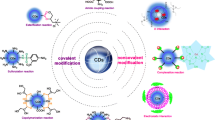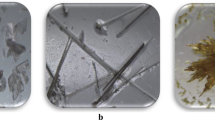Abstract
Although significant effort has been expended to analyze the binding of pyrene in β-cyclodextrin and γ-cyclodextrin, little has been published on the binding of this guest in β-cyclodextrin derivatives (methyl-β-cyclodextrin and 2-hydroxypropyl-β-cyclodextrin) or in mixtures of such derivatives, despite the fact that these derivatives are known to have different supramolecular properties that facilitate unique modes of complexation. Reported herein is a detailed spectroscopic investigation of the binding of pyrene in β-cyclodextrin derivatives and in binary mixtures of cyclodextrins. Py values, defined as the ratio of representative vibronic bands in the fluorescence emission of pyrene, were used to measure changes in the pyrene microenvironment in the presence of the cyclodextrin hosts, and indicated that unmodified β-cyclodextrin is unique in providing a fully hydrophobic environment for pyrene through the use of two cyclodextrins to bind a single pyrene guest. By comparison, both γ-cyclodextrin and modified β-cyclodextrin analogues bind pyrene in a less hydrophobic environment through 1:1 binding stoichiometries that allow for continued interactions between the incompletely encapsulated pyrene guest and the aqueous solvent system. Binary mixtures of cyclodextrins were also explored and reinforce the unique properties of the unmodified β-cyclodextrin host.

The unique binding geometries of pyrene in beta-cyclodextrin and its derivatives leads to measurable fluorescence emission signals, whose information can be used to elucidate the highly structurally dependent binding geometries and stoichiometries






Similar content being viewed by others
References
Prochowicz D, Kornowicz A, Lewinski J (2017) Interactions of native cyclodextrins with metal ions and inorganic nanoparticles: fertile landscape for chemistry and materials science. Chem Rev 117:13461–13501. https://doi.org/10.1021/acs.chemrev.7b00231
Karimian R, Aghajani M (2019) Cyclodextrins and their derivatives as carrier molecules in drug and gene delivery systems. Curr Org Chem 23:1256–1269. https://doi.org/10.2174/1385272823666190627115422
Cova TFGG, Murtinho D, Pais AACC, Valente AJM (2018) Cyclodextrin-based materials for removing micropollutants from wastewater. Curr Org Chem 22:2150–2181. https://doi.org/10.2174/1385272822666181019125315
Wang S-Y, Li L, Xiao Y, Wang Y (2019) Recent Advances in Cyclodextrins-Based Chiral-Recognizing Platforms. TrAC Trends Anal Chem. 121:115691. https://doi.org/10.1016/j.trac.2019.115691
De Rosa M, La Manna P, Talotta C, Soriente A, Gaeta C, Neri P (2018) Supramolecular organocatalysis in water mediated by macrocyclic compounds. Frontiers Chem 6:84/1–84/16. https://doi.org/10.3389/fchem.2018.00084
Tao Y, Gu X, Deng L, Qin Y, Xue H, Kong Y (2015) Chiral recognition of d-tryptophan by confining high-energy water molecules inside the cavity of copper-modified β-cyclodextrin. J Phys Chem C 119:8183–8190. https://doi.org/10.1021/acs.jpcc.5b00927
Schneider H-J (2015) Dispersive interactions in solution complexes. Acc Chem Res 48:1815–1822. https://doi.org/10.1021/acs.accounts.5b00111
Wagner BD (2012) Hydrogen bonding of excited states in supramolecular host-guest inclusion complexes. Phys Chem Chem Phys 14:8825–8835. https://doi.org/10.1039/c2cp40310b
Naidoo KJ, Chen JY-J, Jansson JLM, Widmalm G, Maliniak A (2004) Molecular properties related to the anomalous solubility of β-Cyclodextrin. J Phys Chem B 108:4236–4238. https://doi.org/10.1021/jp037704q
Marttin E, Verhoef JC, Merkus FWHM (1998) Efficacy, safety, and mechanism of cyclodextrins as absorption enhancers in nasal delivery of peptide and protein drugs. J Drug Targeting 6:17–36. https://doi.org/10.3109/10611869808997878
Onuchak LA, Kuraeva YG, Evdokimova MA, Golov AA (2019) Space filling of permethylated β-cyclodextrin by volatile hydrophobic and hydrophilic guests in polyethylene glycol. J Chinese Chem Soc 66:157–163. https://doi.org/10.1002/jccs.201800222
Sa Couto AR, Ryzhakov A, Loftsson T (2018) 2-hydroxypropyl-β-cyclodextrin aggregates: identification and development of analytical techniques. Mater 11:1971/1–1971/16. https://doi.org/10.3390/ma11101971
Serio N, Levine M (2015) Efficient extraction and detection of aromatic toxicants from crude oil and tar balls using multiple cyclodextrin derivatives. Marine Pollution Bull 95:242–247. https://doi.org/10.1016/j.marpolbul.2015.04.008
Serio N, Moyano DF, Rotello VM, Levine M (2015) Array-based detection of persistent organic pollutants via cyclodextrin promoted energy transfer. Chem Commun 51:11615–11618. https://doi.org/10.1039/C5CC04153H
DiScenza DJ, Levine M (2016) Selective detection of non-aromatic pesticides via cyclodextrin-promoted fluorescence modulation. New J Chem 40:789–793. https://doi.org/10.1039/C5NJ02357B
Chaudhuri S, DiScenza DJ, Verderame M, Cromwell B, Levine M (2019) Colorimetric detection of polycyclic aromatic hydrocarbons using supramolecular cyclodextrin dimer-squaraine constructs. Supramol Chem 31:211–219. https://doi.org/10.1080/10610278.2019.1579332
Serio N, Miller K, Levine M (2013) Efficient detection of polycyclic aromatic hydrocarbons and polychlorinated biphenyls via three-component energy transfer. Chem Commun 49:4821–4823. https://doi.org/10.1039/c3cc40534f
DiScenza DJ, Lynch J, Feder E, Levine M (2018) Detection of bisphenol a and derivatives in human urine via cyclodextrin-promoted fluorescence modulation. Anal Methods 10:3783–3790. https://doi.org/10.1039/C8AY00733K
DiScenza DJ, Smith MA, Intravaia LE, Levine M (2019) Efficient detection of phthalate esters in human saliva via fluorescence spectroscopy. Anal Lett 52:479–495. https://doi.org/10.1080/00032719.2018.1471086
DiScenza DJ, Levine M (2016) Sensitive and selective detection of alcohols via fluorescence modulation. Supramol Chem 28:881–891. https://doi.org/10.1080/10610278.2016.1140897
DiScenza DJ, Lynch J, Miller J, Verderame M, Levine M (2017) Detection of organochlorine pesticides in contaminated marine environments via cyclodextrin-promoted fluorescence modulation. ACS Omega 2:8591–8599. https://doi.org/10.1021/acsomega.7b00991
Serio N, Chanthalyma C, Prignano L, Levine M (2013) Cyclodextrin-enhanced extraction and energy transfer of carcinogens in complex oil environments. ACS Appl Mater Interfaces 5:11951–11957. https://doi.org/10.1021/am403702n
Serio N, Chanthalyma C, Peters S, Levine D, Levine M (2015) 2-hydroxypropyl beta-cyclodextrin for the enhanced performance of dual function extraction and detection systems in complex oil environments. J Inclusion Phenom Macrocyclic Chem 81:341–346. https://doi.org/10.1007/s10847-014-0460-0
Karuppannan S, Chambron J-C (2011) Supramolecular chemical sensors based on pyrene monomer-excimer dual luminescence. Chem - Asian J 6:964–984. https://doi.org/10.1002/asia.201000724
Zhang Q, Deng T, Li J, Xu W, Shen G, Yu R (2015) Cyclodextrin supramolecular inclusion-enhanced pyrene excimer switching for time-resolved fluorescence detection of biothiols in serum. Biosensors Bioelectronics 68:253–258. https://doi.org/10.1016/j.bios.2015.01.004
Avakyan VG, Nazarov VB, Odinokov AV, Koshkin AV, Alfimov MV (2016) Structure and aggregation of β-cyclodextrin-pyrene-analyte supramolecular sensor: absorption/emission spectra and simulations. J Luminescence 180:328–340. https://doi.org/10.1016/j.jlumin.2016.08.051
Eddaoudi M, Coleman AW, Prognon P, Lopez-Mahia P (1996) Steady state fluorescence studies of the complexes between pyrene and per-6-o-tert-butyldimethylsilyl α-, β- and γ-cyclodextrins. J Chem Soc Perkin Trans 5:955–959
Street KW Jr (1987) Cyclodextrin cavity polarity and chromatographic implications. J Liq Chromatography 10:655–662. https://doi.org/10.1080/01483918708069016
Reichardt C (1994) Solvatochromic dyes as solvent polarity indicators. Chem Rev 94:2319–2358. https://doi.org/10.1021/cr00032a005
Camerman A, Trotter J (1965) The crystal and molecular structure of pyrene. Acta Cryst 18:636–643. https://doi.org/10.1107/S0365110X65001494
Lissi EA, Gunther G, Zanocco AL (1996) Evaluation of association constants from fluorescence data: a corrected method. Photochem Photobiol 63:709–712
Munoz de la Pena A, Ndou T, Zung JB, Warner IM (1991) Stoichiometry and formation constants of pyrene inclusion complexes with β- and γ-Cyclodextrin. J Phys Chem 95: 3330–3334. https://doi.org/10.1021/j100161a067
Ravelet C, Ravel A, Grosset C, Villet A, Geze A, Wouessidjewe D, Peyrin E (2002) Stoichiometry and formation constants of six PAHs with γ-Cyclodextrin, determined by HPLC using a cyano stationary phase. J Liq Chromatography Related Technol 25:421–432. https://doi.org/10.1081/JLC-120008757
Radaram B, Potvin J, Levine M (2013) Highly efficient non-covalent energy transfer in all-organic macrocycles. Chem Commun 49:8259–9261. https://doi.org/10.1039/c3cc45128c
Dyck ASM, Kisiel U, Bohne C (2003) Dynamics for the assembly of pyrene-γ-cyclodextrin host-guest complexes. J Phys Chem B 107:11652–11659. https://doi.org/10.1021/jp035544c
Brown RS, Szolar OHJ, Luong JHT (1996) Cyclodextrin-aided capillary electrophoretic separation and laser-induced fluorescence detection of polynuclear aromatic hydrocarbons (PAHs). J Molec Recognition 9(5/6): 515–523. https://doi.org/10.1002/(SICI)1099-1352(199634/12)9:5/6<515::AID-JMR294>3.0.CO;2-5
Acknowledgements
Funding for this work was provided by the National Science Foundation, through grant number 1453483.
Author information
Authors and Affiliations
Corresponding author
Additional information
Publisher’s Note
Springer Nature remains neutral with regard to jurisdictional claims in published maps and institutional affiliations.
Electronic supplementary material
ESM 1
(DOCX 123 kb)
Rights and permissions
About this article
Cite this article
Levine, M., Smith, B.R. Enhanced Characterization of Pyrene Binding in Mixed Cyclodextrin Systems via Fluorescence Spectroscopy. J Fluoresc 30, 1015–1023 (2020). https://doi.org/10.1007/s10895-020-02572-5
Received:
Accepted:
Published:
Issue Date:
DOI: https://doi.org/10.1007/s10895-020-02572-5




